

Strategies for Learning from Failure. The wisdom of learning from failure is incontrovertible.

Yet organizations that do it well are extraordinarily rare. This gap is not due to a lack of commitment to learning. Managers in the vast majority of enterprises that I have studied over the past 20 years—pharmaceutical, financial services, product design, telecommunications, and construction companies; hospitals; and NASA’s space shuttle program, among others—genuinely wanted to help their organizations learn from failures to improve future performance. Theory of Change vs Logical Framework – what’s the difference? Over the last few decades there has been an ongoing debate in the international development community about the best way to describe how programs lead to results.
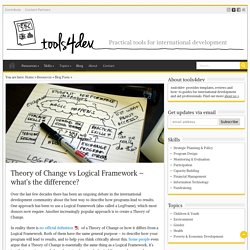
One approach has been to use a Logical Framework (also called a LogFrame), which most donors now require. Another increasingly popular approach is to create a Theory of Change. Risk Analysis and Risk Management - Decision Making from MindTools.com. Data Science for Startups: Introduction. To Innovate Like a Startup, Make Decisions Like VCs Do. Executive Summary The model for creating new growth that we see in successful innovation hubs everywhere involves two sides: the entrepreneurial side, responsible for managing the discovery, validation, and development of new businesses, and the venture side, responsible for managing a portfolio of these businesses with the use of investment theses and funding decisions.
Applying a lean approach in your organization is getting half of the model right, but it is not enough. For enterprises to create successful new growth systems, they need more than just lean startup methodologies: They also need venture capital investment mindsets and mechanics. They need what we call a growth board, a group of senior executives within an organization that meet regularly to review, discuss, and fund or kill growth initiatives. Against metrics: how measuring performance by numbers backfires. More and more companies, government agencies, educational institutions and philanthropic organisations are today in the grip of a new phenomenon.
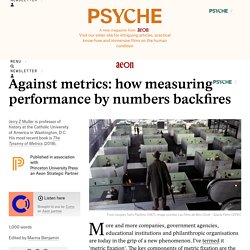
I’ve termed it ‘metric fixation’. Agile-Book. Home → Agile-Book Welcome to the The Art of Agile Development book site!

Here, you'll find a cornucopia of bonus material, such as downloadable posters, behind-the-scenes material, and new insights. For bonus features and online text, follow the links in the table of contents. Sections that include full text are marked with a star. Ruthless Prioritization – The Black Box of Product Management.
What is Kanban? Does your brain always feel like you have a million tabs open?

Do you feel like you’re always switching from one task to another, struggling to focus on any one thing for long enough to make progress? Do you feel like you work nonstop, but are never as productive as you’d like to be? Does your team struggle with basic communication, causing issues such as duplicate efforts, defects, rework, and more? If you’ve answered yes to any of these questions, you aren’t alone. A vast majority of knowledge workers struggle with these very same problems.
A (Very) Short History of Kanban. Why you should stop using product roadmaps and try GIST Planning. Principles behind the Agile Manifesto. We follow these principles: Our highest priority is to satisfy the customer through early and continuous delivery of valuable software.
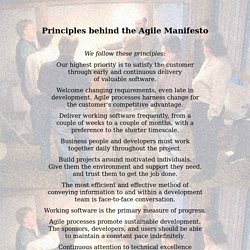
Welcome changing requirements, even late in development. Agile processes harness change for the customer's competitive advantage. Deliver working software frequently, from a couple of weeks to a couple of months, with a preference to the shorter timescale. Business people and developers must work together daily throughout the project. Build projects around motivated individuals. The most efficient and effective method of conveying information to and within a development team is face-to-face conversation. Working software is the primary measure of progress. Understanding how Design Thinking, Lean and Agile Work Together. The ideas of agile are great.

It’s the way it has been codified into rituals and certifications and rolled out mindlessly that misses the point. Understanding Semantic Straitjackets: How today’s management science stifles creativity, innovation and responsiveness — and what to do about it – Wirearchy. Posted on: Monday October 12th, 2015 / (This essay has benefitted greatly from criticism and input from Thierry de Baillon, CV Harquail, Dominique Turcq, Steve Seager, Johnnie Moore, Kevin Barron, Dave Pollard, John Kellden and various discussions with other thoughtful friends)..
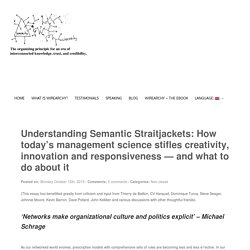
‘Networks make organizational culture and politics explicit’ – Michael Schrage. Donella Meadows recommendations for how to dance with and intervene in systems. Donella H.Meadows was one of the co-authors of the 1972 Club of Rome Report on Limits to Growth which contributed to putting the issue of sustainability on the agenda of business and governments.
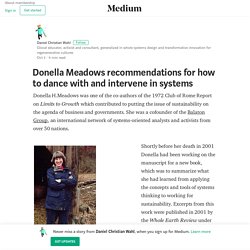
The Systems Thinker - Systems Thinking - Tool/Concept/Definition. Definition Lack of systems thinking produces a mental model based mostly on what you can physically see.
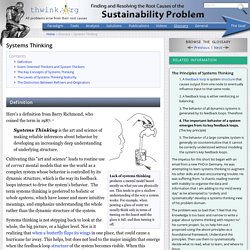
This tends to give a shallow understanding of the way a system works. For example, when pouring a glass of water we usually think only in terms of turning on the faucet until the glass is full, and then turning it off. Here's a definition from Barry Richmond, who coined the term in 1987: Systems Thinking is the art and science of making reliable inferences about behavior by developing an increasingly deep understanding of underlying structure. Cultivating this "art and science" leads to routine use of correct mental models that see the world as a complex system whose behavior is controlled by its dynamic structure, which is the way its feedback loops interact to drive the system's behavior. Systems thinking is not stepping back to look at the whole, the big picture, or a higher level.
Etsy’s Debriefing Facilitation Guide for Blameless Postmortems. Blameless PostMortems and a Just Culture. Last week, Owen Thomas wrote a flattering article over at Business Insider on how we handle errors and mistakes at Etsy. I thought I might give some detail on how that actually happens, and why. Anyone who’s worked with technology at any scale is familiar with failure. Focus Improvement on the Manufacturing Constraint. Core Concept The core concept of the Theory of Constraints is that every process has a single constraint and that total process throughput can only be improved when the constraint is improved. A very important corollary to this is that spending time optimizing non-constraints will not provide significant benefits; only improvements to the constraint will further the goal (achieving more profit). Thus, TOC seeks to provide precise and sustained focus on improving the current constraint until it no longer limits throughput, at which point the focus moves to the next constraint.
The underlying power of TOC flows from its ability to generate a tremendously strong focus towards a single goal (profit) and to removing the principal impediment (the constraint) to achieving more of that goal. The Small Batches Principle. The January/February issue of acmqueue is out now Everything Sysadmin. DevOps Kaizen: Practical Steps to Start & Sustain a Transformation.
David Anderson Kanban At Q Con. Value Stream Mapping (Lean Tool) Tutorial. 8 Essential Online Tools For Getting More Work Done. Know the Difference Between Your Data and Your Metrics. How many views make a YouTube video a success? The only metric that matters. I've been lucky to be part of the early growth of several really interesting and now important networks including LinkedIn, Facebook, and Twitter. How to Use a Single Metric to Run Your Startup. Collecting data is easy. There are lots of tools out there and ways to gather data about everything that’s happening with your business, from lead generation through to customer satisfaction. Atul Gawande: for the first time in human history, ineptitude is a bigger problem than ignorance. Execution Is a People Problem, Not a Strategy Problem. Paul,* the CEO of Maxreed, a global publishing company, was having trouble sleeping. What Every Company Should Know About Agile Software Development. Does your company make medical devices?
Strategy Maps: A Primer. Constructing a strategy map, as we’ve said, produces many benefits: senior team alignment, clarification of the strategy, ease of communication to employees, and can help generate enthusiasm by employees for the strategy. But in reality, creating a strategy map is just the beginning of the work required for strategy execution. In our book, Leading Strategy Execution, we devote two chapters to what leaders need to do once the strategy map is complete. Chapter Six, “Aligning Local Effort (Job Three),” acknowledges that strategies get carried out in work units, not at the top of the organization, and guide the reader in thinking through how the top can align itself with the middle-level. Organigraphs: Drawing How Companies Really Work. An Empirical Framework For Learning (Not a Methodology)